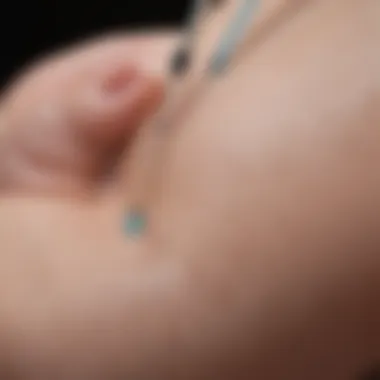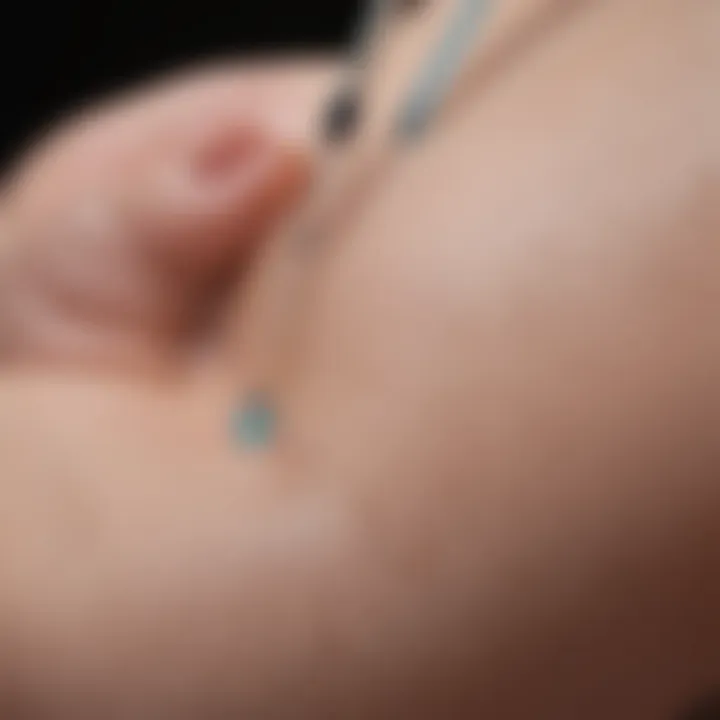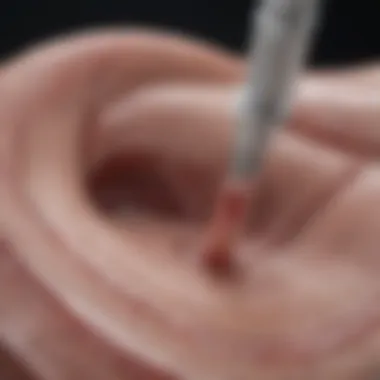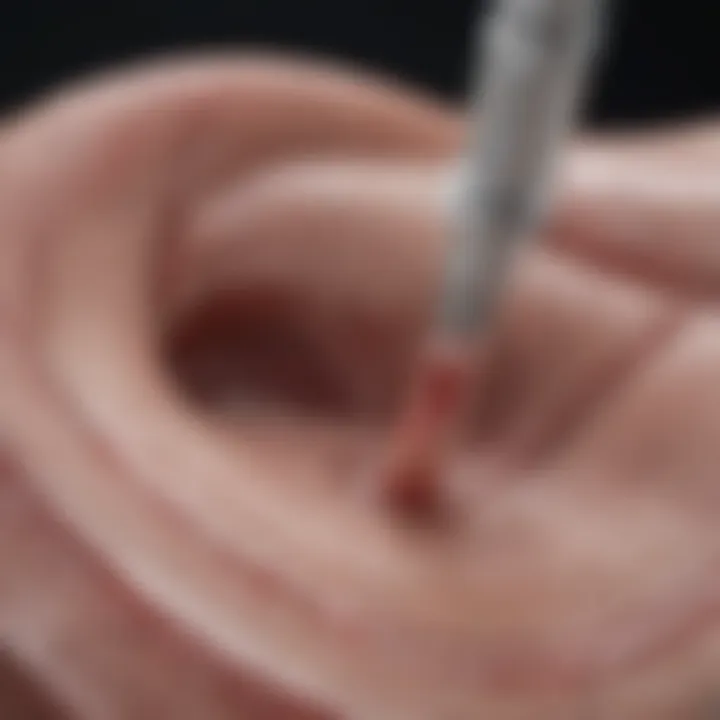Comprehensive Guide to Urinary Catheter Insertion


Article Overview
Purpose of the Article
This article aims to provide a thorough understanding of urinary catheter insertion, detailing not only the procedural aspects but also the broader context in which these procedures are conducted. A urinary catheter is a flexible tube that is inserted into the bladder to drain urine. As a vital component in various medical settings, including hospitals and outpatient facilities, the need for a detailed guide becomes apparent. This guide caters to healthcare professionals, students, and researchers who seek to solidify or expand their existing knowledge.
Relevance to Multiple Disciplines
Urinary catheter insertion crosses various disciplines. It is essential in urology, nursing, geriatrics, and emergency medicine. Its relevance spans from patients with chronic conditions to those facing temporary needs due to surgery or acute illness. Understanding the nuances of catheter insertion is critical for ensuring patient safety, enhancing comfort, and minimizing complications during and after the procedure.
Research Background
Historical Context
The concept of urinary catheterization dates back to ancient civilizations, with evidence of its use in Roman and Egyptian societies. Over the years, the materials and techniques have evolved significantly. Initially, catheters were made from materials like silver, rubber, or animal bladders, which posed risks of infection and discomfort. Modern advancements have markedly improved the design, including the introduction of latex and silicone materials, which are more biocompatible.
Key Concepts and Definitions
Understanding key terms is fundamental for appreciating the intricacies of urinary catheter insertion. Here are some relevant definitions:
- Indications: Situations or medical conditions that warrant catheter insertion. Common indications include urinary retention, monitoring of urine output, and some surgical procedures.
- Complications: Possible adverse effects resulting from catheter insertion, including urinary tract infections, injury to the urethra, or bladder spasms.
- Post-insertion care: The procedures and protocols followed after catheter insertion to ensure patient comfort and minimize risks.
"The evolution of urinary catheters has transformed patient care, but practitioners must remain vigilant to the risks associated with their use."
"The evolution of urinary catheters has transformed patient care, but practitioners must remain vigilant to the risks associated with their use."
By exploring these sections, the reader will gain insights into the procedural, technological, and clinical contexts of urinary catheter insertion. The combination of historical, technical, and clinical knowledge aims to bolster the reader's understanding, ultimately leading to improved patient outcomes.
Intro to Urinary Catheter Insertion
Urinary catheter insertion is a critical procedure in modern medicine. It serves various essential functions, from facilitating urine drainage to addressing specific medical conditions. Understanding this procedure is vital for healthcare professionals and students, as it directly impacts patient care and outcomes.
This article covers the importance of urinary catheters, including their indications, techniques, and potential complications. Proper education on the insertion process is important because it can ensure patient safety. When executed correctly, urinary catheterization can enhance the quality of care significantly and improve comfort for individuals who require it.
Key Elements of Catheter Insertion
- Patient Comfort: Ensuring the comfort of patients during and after the procedure is crucial. Awareness of the emotional state of the patient can help ease anxieties.
- Clinical Indications: Understanding when catheterization is necessary helps practitioners make informed decisions. Certain situations, such as acute urinary retention or specific surgical procedures, may render catheter insertion a requisite.
- Equipment Familiarity: Knowledge of the various catheters and the appropriate equipment is fundamental. Different types of urinary catheters have unique applications.
"Proper training and understanding can drastically reduce complications associated with urinary catheter insertion."
"Proper training and understanding can drastically reduce complications associated with urinary catheter insertion."
Benefits of Effective Catheterization
Effective catheter insertion provides several benefits, including:
- Relief from Retention: It can alleviate discomfort caused by urinary retention.
- Accurate Monitoring: Allows for precise monitoring of urine output, aiding in clinical assessments.
- Enhanced Recovery: For postoperative patients, timely catheterization can facilitate recovery and prevent deterioration.
In summary, urinary catheter insertion is not merely a procedural task; it involves a nuanced understanding of patient needs, anatomical knowledge, and efficacy of techniques. Through this guide, we aim to empower readers with insights that will improve not only their practical skills but also the overall patient experience.
Understanding Urinary Catheters
Urinary catheters play a critical role in modern healthcare. Understanding their various types and components is essential for effective patient management. Urinary catheters are devices that help drain urine from the bladder. They are used in several clinical situations, ranging from acute urinary retention to postoperative care. Knowledge of catheters contributes to improved patient comfort and safety.
Types of Urinary Catheters
Intermittent Catheters
Intermittent catheters are designed for short-term use. They are inserted, drained, and then removed. This type of catheter is particularly beneficial for individuals with neurogenic bladder or those requiring bladder training. A key characteristic of intermittent catheters is their ease of use. They allow for self-catheterization. This feature promotes independence in patients who need regular bladder drainage. The main advantage is less risk of long-term complications, such as infections. On the downside, not all patients may find self-catheterization comfortable.
Indwelling Catheters
Indwelling catheters, sometimes referred to as Foley catheters, are left in place for extended periods. They are secured in the bladder by a balloon that is inflated after insertion. A significant aspect of indwelling catheters is that they continuously drain urine. They are commonly used for postoperative needs and patients with long-term urinary retention. Their main benefit is that they require less frequent attention. However, they carry an increased risk of urinary tract infections. Understanding this balance is crucial when considering their use.
Suprapubic Catheters
Suprapubic catheters are inserted directly into the bladder through the abdominal wall. This method is particularly advantageous for patients who have urethral issues or require long-term catheterization. A key feature of suprapubic catheters is that they can reduce the risk of urethral trauma and infection, which is a significant concern with internal catheters. These catheters also allow for easier mobility and comfort for the patient. Nevertheless, surgical placement is necessary, which may not be suitable for every patient.
Components of a Urinary Catheter
Catheter Material
The material of a urinary catheter is essential for its functionality and patient comfort. Common materials include latex, silicone, and PVC. A key distinction in catheter materials is their biocompatibility. Silicone catheters are often preferred for longer use due to their low friction and reduced risk of irritation. While latex catheters are effective, they can cause allergic reactions in some patients, limiting their use.
Balloon Specifications
Balloon catheters feature a balloon at the end, which is inflated to secure it in place within the bladder. The size of the balloon plays a crucial role in its effectiveness and safety. Standard balloon sizes usually range from 5 cc to 30 cc, depending on the specific clinical circumstances. An adequate balloon size ensures that the catheter remains in position without causing trauma to the bladder wall. However, oversized balloons may cause discomfort and increase the risk of complications.
Drainage Bags
Drainage bags are essential components of the catheter system. These bags collect the drained urine and may either be connected to the catheter or be portable. The primary types are leg bags and bedside bags. Leg bags are discreet and allow for mobility, making them ideal for active patients. On the other hand, bedside bags are designed for patients who are bedridden. The choice of drainage bag significantly influences patient comfort and adherence to catheter management protocols.
A proper understanding of urinary catheters can enhance patient safety and experience.
A proper understanding of urinary catheters can enhance patient safety and experience.
Indications for Catheter Insertion


Understanding the indications for catheter insertion is fundamental for healthcare providers. The decision to use a urinary catheter is based on a balance of necessity, patient safety, and clinical consideration. This section delves into key reasons for cathater insertion, including acute urinary retention, preoperative needs, and urine output monitoring. Recognizing these indications ensures appropriate use and minimizes potential complications.
Acute Urinary Retention
Acute urinary retention can be a distressing condition where a patient cannot voluntarily urinate. This situation can lead to significant discomfort, bladder distention, and potential injury to the urinary tract. Common causes of acute urinary retention include benign prostatic hyperplasia, urethral strictures, or neurological disorders.
In cases of acute retention, catheterization serves an immediate function. Upon insertion, the catheter helps relieve pressure on the bladder, providing symptom relief almost instantly. There are some considerations during the process, including the underlying cause of retention. If it is a reversible condition, treating that underlying issue may limit the duration of catheter dependence. Proper assessment and urgent intervention reduce the risk of long-term renal impairment or infection, highlighting the importance of timely catheter insertion.
Preoperative and Postoperative Needs
In surgical settings, urinary catheters are often utilized for several reasons. First, they facilitate urine drainage during procedures, preventing bladder distention that could complicate surgery. Catheters may be inserted before surgeries that involve the lower abdomen, pelvic area, or groin to provide a clear operative field.
Postoperatively, these catheters continue to provide essential functions. They help monitor urine output, which is critical for assessing kidney function and hydration status. Furthermore, in surgeries involving large fluid shifts, urine output can be a vital indicator of a patient's recovery. Understanding when to insert a catheter can support better postoperative outcomes, ensuring that complications are detected early.
Monitoring Urine Output
Monitoring urine output is essential in various clinical scenarios. When a patient is critically ill, tracking urine output helps in evaluating renal perfusion and overall fluid balance. A urinary catheter is useful here, as it allows for accurate measurement of urine output over time, offering insights that are not possible with intermittent clean catheterization.
For patients with significant fluid volume changes, such as those with heart failure or renal disease, frequent urine output analysis can inform treatment. Clinicians can adjust interventions based on the data gathered from catheter usage, leading to more personalized patient care. Therefore, the use of urinary catheters for monitoring purposes is a vital indication that not only aids in assessment but also guides therapeutic decision-making.
Regular assessment of urinary output is crucial for diagnosing and managing fluid imbalance, particularly post-surgery or during critical illness.
Regular assessment of urinary output is crucial for diagnosing and managing fluid imbalance, particularly post-surgery or during critical illness.
The considerations surrounding catheter insertion provide a structured approach to enhance patient management. Thus, understanding these indications improves clinical practice, elevating care standards.
Anatomy Relevant to Catheterization
Understanding the anatomy relevant to catheterization is fundamental for healthcare professionals engaged in this procedure. A thorough knowledge of the urinary system structures ensures safe and effective catheter insertion. Recognizing these anatomical structures helps to minimize complications and improve patient outcomes. Each component from the kidneys to the urethra has its specific characteristics that affect catheterization practices.
Anatomical Structures of the Urinary Tract
Kidneys
The kidneys serve as vital organs in the urinary system, primarily responsible for filtering blood and producing urine. Their unique features include the nephrons, which actively filter waste and reabsorb essential substances. Understanding kidney function is crucial because it influences overall fluid management in patients. When inserting a catheter, checking kidney health can guide decisions for specific patient populations, ensuring effective management of conditions like acute urinary retention. The non-visible nature of these organs creates challenges in assessing their function indirectly during catheter procedures, making knowledge of their positioning and function critical.
Ureters
The ureters are the tubes that transport urine from the kidneys to the bladder. Their muscular structure is essential for moving urine through peristaltic contractions. This anatomical aspect is relevant when considering urinary catheter techniques, especially in patients with obstructed ureters. Familiarity with the ureters' pathway helps avoid complications during insertion. Their length and gradient vary between individuals, influencing catheter choice and potential success rates. Proper knowledge of ureter positioning ensures accurate catheter placement and reduces the risk of injury during the process.
Bladder
The bladder functions as a reservoir for urine, expanding to accommodate various volumes. It is predominantly muscular, which allows for contraction and relaxation during urination. The anatomy of the bladder must be taken into account during catheter insertion, particularly in understanding the trigone area’s sensitivity and its role in inhibiting or triggering urination. The ability to palpate the bladder or assess its fullness provides essential guidance and diagnosis, making it a key structure in managing urinary catheterization. Knowing the bladder's anatomical landmarks aids in avoiding erroneous placements and optimizing catheter care post-insertion.
Urethral Anatomy
Male Urethra
The male urethra is significantly longer than its female counterpart, measuring approximately 20 cm. It serves dual functions, facilitating the passage of urine and semen. Understanding this anatomical detail is beneficial as it influences the choice and technique of catheterization. The varied segments present in the male urethra introduce more complexity than in females, making awareness of its anatomical features crucial to successful catheter insertion. Differences in resistance within the urethra must be considered to avoid discomfort and injury.
Female Urethra
The female urethra, in contrast, is shorter, measuring about 4 cm. Its straightforward anatomy aids in quicker access during catheter insertion, reducing the risk of complications. However, care should be taken to correctly identify its position, as anatomical variations can exist. The female urethra's proximity to the vaginal canal necessitates attention to irrigation techniques to prevent infection. The simplicity of the female anatomy often results in faster procedures, but practitioners must remain vigilant to avoid misplacements that could lead to discomfort or injury.
Understanding these anatomical structures thoroughly optimizes the catheterization process, enhances patient comfort, and reduces risks associated with the procedure.
Preparation for Catheter Insertion
Preparing for urinary catheter insertion is a crucial step in ensuring both patient safety and comfort. This phase involves multiple components that collectively improve the procedure's success rate. Proper preparation can help minimize complications and foster a more positive experience for the patient.
Patient Education and Consent
Educating the patient about the catheterization process is essential. It helps to alleviate anxiety and apprehension. A clear explanation regarding the purpose, procedure, and aftercare can also promote compliance and encourage patients to ask questions.
Obtaining informed consent is another key element. Patients should understand the risks and benefits, allowing them to make a well-informed decision. Documenting consent demonstrates adherence to legal and ethical standards. This should not be treated as a mere formality but rather as an integral part of the patient-centered approach in healthcare.
Sterile Technique and Equipment Preparation
Maintaining a sterile technique is vital in reducing the risk of urinary tract infections (UTIs) and other complications. Healthcare providers must follow stringent protocols to ensure the equipment used is free from contamination.
Necessary Supplies
The supplies needed for catheter insertion include a urinary catheter, sterile lubricant, sterile gloves, an antiseptic solution, and urine drainage bags. Each item plays a specific role in ensuring the procedure's safety. For example, using a high-quality, latex-free catheter minimizes the risk of allergic reactions, making it a beneficial choice for diverse patient populations.
A key characteristic of necessary supplies is that they are pre-packaged as sterile kits. This feature simplifies the preparation process, reducing the likelihood of errors. However, the disadvantages may involve increased costs for healthcare facilities. It is crucial to balance cost-effectiveness with ensuring patient safety.
Setting Up a Sterile Field
Establishing a sterile field is essential for successful catheterization. This involves creating an area that is free from potential contaminants, ensuring that all instruments and supplies remain sterile until used. The key characteristic of this practice centers around safeguarding the patient from hospital-acquired infections.
A unique advantage of setting up a sterile field is that it allows the clinician to have all necessary tools within reach while maintaining a clean environment. Nonetheless, it may require additional time and resources to correctly set up, which can be a challenge in busy clinical settings.
Proper preparation for catheter insertion is not just best practice; it is an ethical responsibility towards patient welfare.
Proper preparation for catheter insertion is not just best practice; it is an ethical responsibility towards patient welfare.
Overall, preparation for catheter insertion encompasses patient education, consent acquisition, and strict adherence to sterile procedures. Each of these elements contributes fundamentally to improving outcomes and protecting patient health.
Techniques of Catheter Insertion


The Techniques of Catheter Insertion serve as a cornerstone for effective urinary catheter placement. Proper technique ensures not only the success of the procedure but also the comfort and safety of the patient. Mastering these techniques minimizes complications, such as infections or urethral injury, making it essential for healthcare professionals to be well-versed in this segment.
Step-by-Step Insertion Process
This section outlines the critical steps in the catheter insertion process, emphasizing precision and safety in every phase.
Locating the Urethral Opening
Locating the urethral opening is fundamental for any catheterization procedure. This step involves identifying the correct anatomical position to avoid misplacement. Accurate location of the urethra helps to reduce discomfort and trauma during insertion. The key characteristic of this process is the clinician's ability to visualize the urethral anatomy accurately. This is a beneficial choice because it leads to higher success rates in catheter placement.
The unique feature of this step is that it requires knowledge of individual anatomy, as this can vary between patients. Proper techniques may involve using a flashlight or another light source to enhance visibility. The advantage here is a more straightforward approach that limits complications arising from incorrect attempts to locate the opening, but the disadvantage is that a lack of skill might lead to patient discomfort or increased risk of infection.
Insertion Angle and Depth
The insertion angle and depth are crucial for a successful catheterization. Insertions must be done at a precise angle to facilitate the smooth entry of the catheter while avoiding injury to surrounding tissues. The key characteristic here is its direct impact on the procedure's efficiency and the patient's experience during and after insertion. This concept is beneficial in minimizing trauma.
The unique aspect of this consideration is how different catheters may require different techniques, depending on their design. The main advantage is that utilizing the appropriate angle and depth significantly reduces the risk for urethral injury. However, if done improperly, it can lead to complications and increased discomfort for the patient.
Inflating the Catheter Balloon
Inflating the catheter balloon is a essential step in securing the catheter within the bladder. This process allows for proper positioning and helps maintain catheter placement. The key characteristic of this procedure is the necessity for a gentle approach when inflating, using the correct amount of sterile water as specified by catheter guidelines. This is a beneficial practice because, when performed correctly, it ensures that the catheter does not dislodge, which is crucial for effective drainage.
The unique feature of this step lies in the attention to detail required during balloon inflation. The primary advantage is effective stabilization of the catheter, contributing to reduced risks of bladder spasms or leakage. On the downside, over-inflation or under-inflation can lead to complications like urinary retention or irritation.
Guidance and Visualization Techniques
Guidance and visualization techniques improve accuracy and safety in catheterization. They provide practitioners with tools to visualize internal structures clearly and ultimately ensure proper catheter placement.
Using a Cystoscope
Using a cystoscope enhances the visibility of relevant anatomical structures during catheter insertion. This device allows healthcare providers to visualize the urethra and bladder in real-time. The key characteristic is that it provides a direct view of the internal anatomy, which significantly increases the precision of catheter placement. This is beneficial because it reduces the likelihood of errors related to anatomical variations or obstructions.
A unique feature of cystoscopy is its ability to facilitate simultaneous interventions, should additional issues be identified during insertion. The primary advantage is clear visualization, helping to guide and adjust techniques as necessary. However, one disadvantage is the equipment's complexity and cost, which may not be available in all settings.
Ultrasound Guidance
Ultrasound guidance is another technique gaining recognition in catheterization. This method involves using ultrasound imaging to visualize bladder placement prior to insertion. A key characteristic is its capability to provide a non-invasive approach to assess bladder volume and position, which informs the practitioner before catheter placement. This makes it a beneficial tool for minimizing complications related to improper placement.
A unique aspect of ultrasound is its adaptability; it can be used for patients with challenging anatomies or when traditional methods are less reliable. The advantage here includes increased confidence during catheter insertion, potentially lowering the risk of injury. However, its disadvantage lies in the requirement of specialized training and equipment that may not be uniformly accessible.
Complications of Urinary Catheterization
Understanding the complications of urinary catheterization is essential for healthcare professionals. Despite being a common procedure, catheterization carries risks that can lead to patient discomfort or serious health issues. Early identification and management of these complications can significantly enhance patient care. In this section, we will elaborate on three significant complications: infections, urethral injuries, and bladder spasms. Each area requires careful consideration to promote both immediate and long-term patient well-being.
Infections
Infections are among the most common complications associated with urinary catheterization. The urinary tract is naturally sterile, and the introduction of a catheter can disrupt this sterile environment. Catheter-associated urinary tract infections (CAUTIs) can occur due to bacteria ascending through the catheter into the bladder. Risk factors include prolonged catheter use, improper insertion technique, and maintenance care. Educating patients on the signs of infection, such as fever or unusual changes in urine, is key in managing this complication.
Preventive strategies include:
- Maintaining sterile technique during insertion.
- Using the smallest effective catheter size to minimize irritation.
- Regularly changing the catheter as per institutional protocols.
- Adequate hydration to facilitate urine flow and flush bacteria from the bladder.
Urethral Injury
Urethral injury can occur during the insertion or removal of urinary catheters. This complication is more prevalent in patients with anatomical abnormalities or previous pelvic trauma. Urethral tears can lead to significant pain, bleeding, and potential long-term complications, including strictures. Proper technique is vital to lower the risk of injury.
Healthcare professionals should be vigilant about:
- Assessing the patient’s anatomical considerations before proceeding.
- Using dilation techniques appropriately if resistance is encountered during insertion.
- Observing any signs of trauma such as blood at the urethral opening or persistent pain post-procedure.
Bladder Spasms
Bladder spasms, often described as sudden and painful contractions of the bladder muscle, can occur after catheter insertion. These spasms may be caused by irritation from the catheter or bladder infections. Patients may report discomfort or urgency to void, complicating their care. Management of bladder spasms can include:
- Anticholinergic medications to reduce spasms.
- Changing the catheter type to a less irritating option if necessary.
- Implementing bladder training exercises to improve control.
It is critical for healthcare providers to understand these complications to effectively educate patients and mitigate risks. The right knowledge and precautions can lead to better outcomes and enhanced patient comfort.
Post-Insertion Care and Monitoring
Post-insertion care and monitoring is a critical component of urinary catheterization. This phase ensures that the catheter remains functional, while also preventing complications that may arise from its presence. Careful post-insertion practices not only promote the health of the urinary tract but also enhance a patient’s overall comfort and dignity during their recovery process.
Assessing Catheter Positioning
Proper placement of the catheter is vital for effective drainage and minimizing the risk of injury. Assessing catheter positioning involves regular checks to confirm that the catheter remains in the correct location in relation to the patient’s anatomy. Factors to consider include:
- Visual Inspection: Checking for any visible signs of discomfort or displacement in the catheter.
- Palpation: For indwelling catheters, palpating the bladder to ensure it is emptying adequately and confirming that no obstruction occurs.
- I&O Charts: Reviewing input and output records to ensure that urine is being appropriately drained.
If a displacement or obstruction is noted, immediate measures should be taken to reposition the catheter as needed, following established protocols. Doing so helps to avoid urethral injury and reduces the likelihood of infections.
Monitoring Urine Output
Monitoring urine output is a fundamental aspect of catheter post-insertion care. Accurate recording of urine output helps nutritional assessment and overall hydration status, guiding further medical interventions if necessary. Important points to include in monitoring urine output are:
- Quantity: Record the volume of urine output at regular intervals. Low or high volumes may indicate complications, such as blockage or dehydration.
- Quality: Assess the characteristics of the urine for color, odor, or presence of blood. Abnormalities can be indicators of infection or other medical issues.
- Timing: Note any significant changes in urine output patterns. Sudden drops may suggest that the catheter is not functioning correctly.
Regular monitoring and documentation are crucial to ensure patient safety and facilitate timely interventions when needed.


Regular monitoring and documentation are crucial to ensure patient safety and facilitate timely interventions when needed.
Care teams should adhere to proper protocols for documenting urine output, ensuring clear communication among all members involved in the patient’s care. This approach ensures a collaborative effort to maintain optimal health outcomes for individuals with urinary catheters.
Maintenance of Urinary Catheters
Maintaining urinary catheters is critical for ensuring patient comfort, reducing risks of infections, and promoting overall health. Regular maintenance protocols can significantly enhance the lifespan of the catheter and improve the patient’s quality of life. Health care providers must understand the significance of these routine practices that involve regular care and cleaning techniques, as well as appropriate timing for catheter changes.
Regular Catheter Care Protocols
Daily Care
Daily care is an essential component of urinary catheter maintenance. This involves checking the catheter for kinks or obstructions that might impede urine flow. Ensuring that the drainage bag is properly positioned below the bladder helps prevent backflow, reducing infection risk.
A key characteristic of daily care is its routine application. Routine checks can catch potential issues before they develop into larger problems. The advantage of this practice lies in its simplicity and effectiveness, allowing healthcare professionals to easily integrate it into their daily workflows. However, the disadvantage may include a time constraint when attending to multiple patients, which could lead to oversight. Nonetheless, the benefits of preventing complications outweigh these challenges.
Cleaning Techniques
Cleaning techniques focus on maintaining hygiene around the catheter insertion site. This action prevents bacteria from entering the urinary tract. Regular cleaning can help minimize the risk of catheter-associated urinary tract infections (CAUTIs).
A key characteristic of cleaning techniques is the use of aseptic methods. The most popular choice involves using a mild soap and water solution to cleanse the area. This approach is beneficial because it effectively reduces pathogens without causing irritation.
A unique feature of these techniques is the use of antiseptics, which can further enhance sterilization. However, care must be taken to choose the appropriate agents, as some can be harsh and lead to adverse reactions. Overall, the proper application of cleaning methods is vital in supporting patient safety and comfort.
Timing for Catheter Change
The timing for catheter change is a crucial aspect of catheter maintenance. Catheters have a recommended lifespan, and timely replacement is essential to reduce the risks of infection and other complications. Depending on the type of catheter used, the duration may vary.
Most healthcare professionals advise changing intermittent catheters after each use, while indwelling catheters typically require changing every 2 to 4 weeks. Regular assessment of the catheter condition is required, as signs of blockage, leakage, or patient discomfort might signal a need for earlier replacement. Keeping a strict schedule for changes can provide a systematic approach and enhances the effectiveness of urinary catheter management.
Emerging Technologies in Catheterization
The field of urinary catheterization is experiencing significant transformation due to emerging technologies. As healthcare practices evolve, the demand for increased patient comfort, reduced complications, and enhanced efficiency drives innovation in catheter design and materials. These advancements not only facilitate better clinical outcomes but also enhance the overall experience for patients during what can be an uncomfortable procedure.
Advancements in Catheter Materials
Recent progress in catheter materials has directly improved the performance of urinary catheters. New polymers and coatings are now frequently utilized to reduce friction during insertion. This enhancement leads to less trauma in the urethra. Modern materials also aim to minimize the risk of infections. Antimicrobial coatings are being integrated into catheter surfaces to deter bacterial growth. This is critical, as catheter-associated urinary tract infections (CAUTIs) are a common complication in catheter use.
Other advancements include the use of hydrophilic coatings that can hydrate when exposed to water. These coatings make the catheter smoother and facilitate easier insertion, improving the patient's experience. Different materials can also adapt properties like elasticity and rigidity, giving clinicians better options to match catheters to individual patient needs.
Innovations in Catheter Design
Catheter design innovations are another notable area of progress. Designs that adapt to the anatomical variations among individuals, especially in differing urethral structures, have become more prevalent. Manufacturers are developing catheters that have flexible tips to conform better to the patient's anatomy, reducing the risk of urethral injury and discomfort.
Moreover, there are designs focusing on ease of handling and insertion. For example, catheter systems are now available with integrated features such as a built-in safety mechanism to prevent accidental dislodgment or unintentional withdrawal. Additionally, some catheters now feature visualization tools that provide real-time feedback during insertion, helping clinicians navigate complex anatomical pathways more effectively.
"The integration of innovative designs and materials in catheters signifies a remarkable stride in ensuring patient safety and enhancing procedural efficacy."
"The integration of innovative designs and materials in catheters signifies a remarkable stride in ensuring patient safety and enhancing procedural efficacy."
These advancements generally focus on improving the patient experience while providing healthcare professionals with tools that can increase precision and reduce complications. As research continues, we can expect more breakthroughs in this critical area of healthcare, ultimately leading to enhanced patient outcomes.
Research and Future Directions
The field of urinary catheterization is on the brink of significant advancements due to ongoing research and a focus on innovation. Understanding the context of current research gaps and the potential for novel innovations is vital for improving the quality of patient care and safety. This section discusses these elements in detail, spotlighting the future of urinary catheter insertion.
Current Research Gaps
Despite the progress made in catheter technology and techniques, several areas still lack comprehensive research. Key gaps include:
- Long-term effects of catheter use: There is a need for studies focusing on the prolonged impact of catheterization on patient outcomes, particularly regarding urinary tract infections and patient comfort.
- Comparative effectiveness of catheter types: More research is needed to evaluate which types of catheters provide the best outcomes in various patient populations, especially in those with complex medical histories.
- Patient education and experience: Understanding patient perceptions and experiences can inform better education programs. Research should focus on how informed patients feel before, during, and after catheterization.
Recognizing and addressing these gaps can empower healthcare providers to make informed decisions, improving overall care.
Potential for Novel Innovations
The future holds numerous potentials for advancements in urinary catheter technology and procedures. Some notable areas of innovation might include:
- Smart catheters: Technology that allows for real-time monitoring of urinary output and potential complications through the integration of sensors may be developed. These smart devices could provide immediate feedback to healthcare providers, enhancing patient safety.
- Antimicrobial coatings and materials: New materials that resist bacterial colonization can be crucial in reducing infection rates associated with catheters.
- Enhanced training tools: Immersive training programs using virtual reality to simulate catheter insertion could improve the skill level of practitioners, leading to more effective outcomes.
Advances in research can lead to groundbreaking changes in how catheter procedures are performed.
Advances in research can lead to groundbreaking changes in how catheter procedures are performed.
Both research gaps and innovative technologies indicate a progressive trend in this field. Continued focus on innovation complemented by thorough research will ultimately lead to improved standards and practices for urinary catheterization.
Ending
The conclusion serves as a crucial element in any comprehensive guide, emphasizing the importance of urinary catheter insertion in clinical practice. As outlined throughout the article, the procedure is not merely a technical task but a pivotal component of patient care in various healthcare settings. Medical professionals must recognize that the effectiveness of catheterization hinges on understanding both its indications and the nuanced techniques for insertion.
Importance of Knowledge
Professionals must maintain a strong foundation of knowledge regarding the urinary anatomy and the different types of catheters available. This knowledge helps in selecting the appropriate type for each patient’s specific situation. Various conditions, such as acute urinary retention or the need for post-operative monitoring, necessitate a tailored approach to catheter insertion.
Safety and Comfort Considerations
Furthermore, the article discusses the importance of patient safety and comfort during the catheterization process. Awareness of potential complications, such as infections or urethral injuries, cannot be overstated. Proper monitoring and care post-insertion are integral to preventing adverse effects and ensuring the physical well-being of patients.
Evolution and Future Directions
The discussion of emerging technologies and current research gaps also sheds light on the evolving nature of catheterization practices. Innovations in catheter materials and design promise to enhance patient outcomes and minimize complications. Staying informed about these developments will empower healthcare professionals to adopt best practices that reflect the latest advancements in the field.
Final Thoughts
In closing, the comprehensive insights provided in this guide about urinary catheter insertion illuminate its significance within healthcare. By applying the knowledge from this article, professionals can enhance their competency, improve patient care, and ultimately contribute to better health outcomes.



